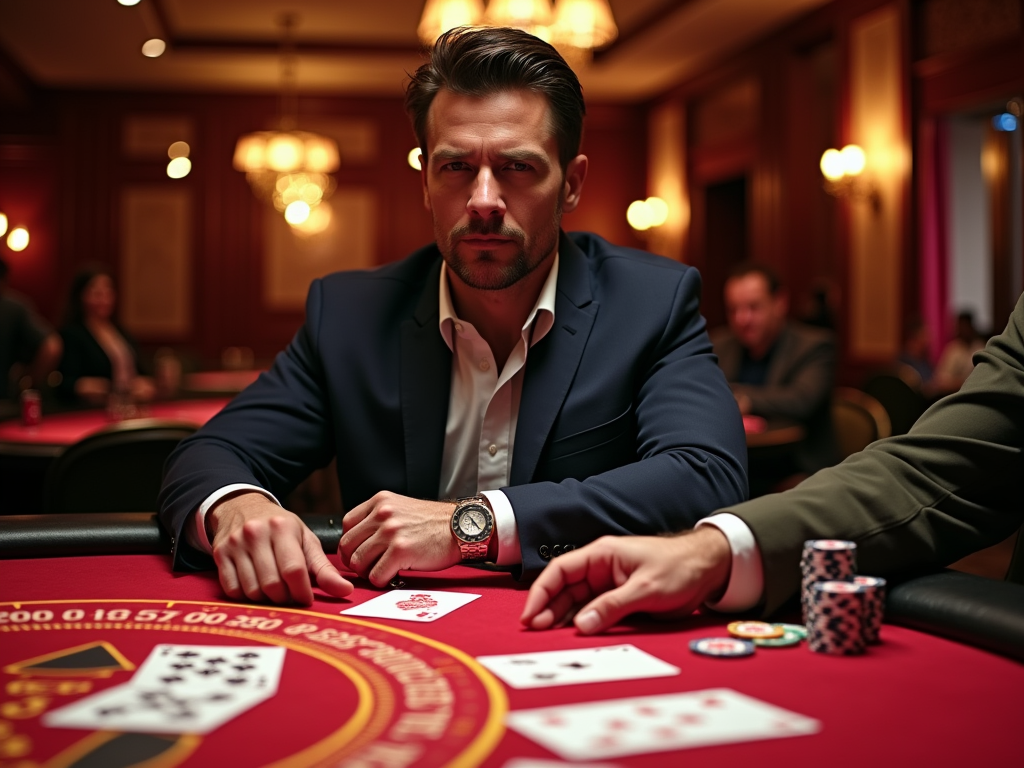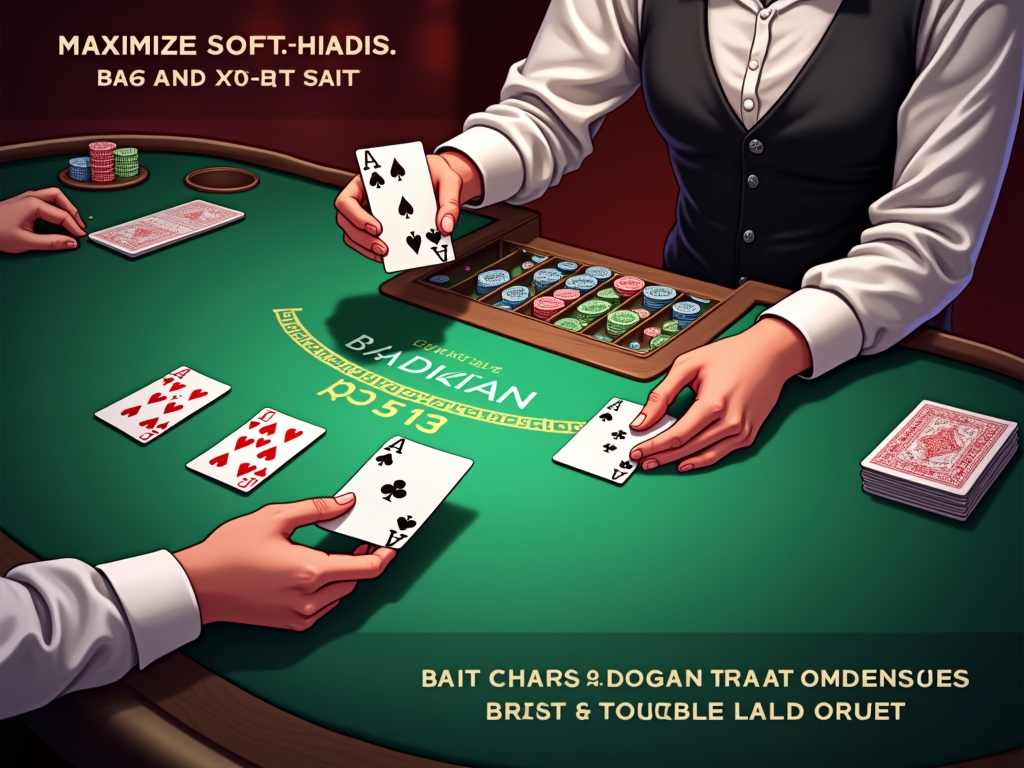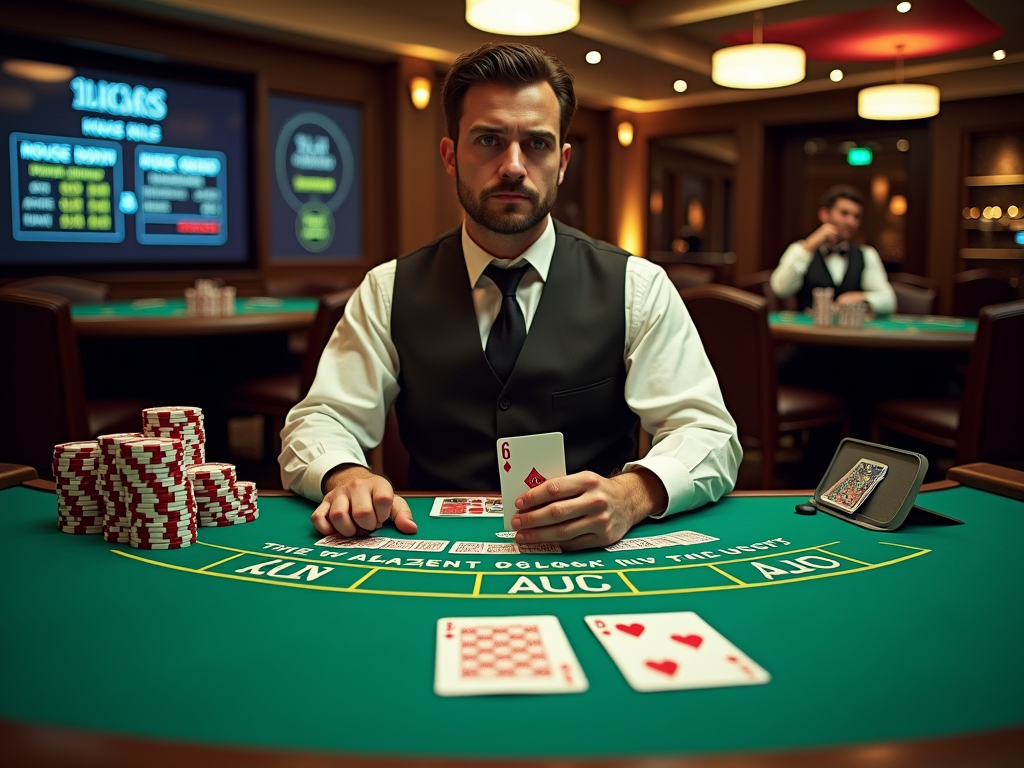Blackjack Mastery Through Strategy
Blackjack mastery hinges on precise mathematical strategies and smart decisions about aggressive versus conservative plays. Strategic decisions directly impact long-term results, with optimal play reducing the house edge from over 2% to just 0.5%.
Key Takeaways
- Always hit on 16 against a dealer’s 10, despite feeling risky, as it’s mathematically correct
- Split Aces and 8s without exception, but never split 5s or 10s
- Double down on 11 against any dealer upcard except an Ace for maximum profit
- Stand on hard totals of 12-16 when the dealer shows cards 2 through 6 due to their high bust probability
- Double down on soft hands (13-17) when the dealer shows weakness with 4, 5, or 6 upcard
I’ve found these strategic decisions bring consistent results at the blackjack table. My experience shows that players often miss crucial opportunities by ignoring basic strategy rules. Each decision point presents a chance to gain an edge through correct play.
Following these guidelines helps maintain discipline during challenging moments. The math backs up each recommendation, creating a solid foundation for successful blackjack play. Strategic consistency matters more than occasional lucky streaks.
With practice, these plays become automatic responses rather than calculated decisions. This mental muscle memory proves essential during extended playing sessions where fatigue can impact judgment.
Remember: the casino maintains its edge through player mistakes, not perfect basic strategy execution. By sticking to proven mathematical choices, I minimize losses during downswings and maximize gains during favorable runs.
The Most Critical Plays That Win (or Lose) Money in Blackjack
High-Impact Decisions That Shape Your Results
I’ve found that hitting on 16 against a dealer’s 10 is the most expensive mistake players make at the blackjack table. While it feels risky to hit on 16, mathematical analysis shows it’s the correct play that will save you money in the long run. Think of it this way — you’re already in a tough spot, but hitting gives you a fighting chance to improve your hand.
Splitting pairs is another area where costly mistakes happen frequently. Here are the non-negotiable splitting rules I follow:
- Always split Aces – this gives you two chances to hit 21
- Always split 8s – playing 16 as one hand is worse than two separate hands starting with 8
- Never split 5s – you’re better off playing it as 10 and doubling down
- Never split 10s – a 20 is already a powerful hand
Maximizing Profits Through Strategic Double Downs
Doubling down on 11 is one of the most profitable plays in blackjack when done correctly. I recommend doubling down against any dealer upcard except an Ace. This aggressive but mathematically sound play puts more money on the table when you have the advantage.
Understanding basic terminology helps make better decisions:
- Hard Hand: A hand without an Ace, or where the Ace must count as 1
- Soft Hand: A hand with an Ace that can count as 1 or 11
- Pat Hand: A standing hand that doesn’t require additional cards
- Double Down: Double your initial bet and receive exactly one more card
- Split: Separate a pair into two hands by matching your original bet
By following perfect basic strategy, which you can learn more about in my complete guide to casino card games, you’ll reduce the house edge to just 0.5%. This is significantly better than the 2%+ edge the casino holds against average players who make decisions based on hunches.
Similar strategic thinking applies to other card games – I cover advanced betting patterns in my analysis of popular betting systems that can help refine your approach to table games.

When the Dealer Shows Weakness: Maximizing Your Profit
The dealer’s upcard can signal prime opportunities to boost your potential winnings in blackjack. I’ll show you exactly how to capitalize on these favorable situations through strategic plays that put the odds in your favor.
Optimal Decisions Against Weak Dealer Cards
Standing on hard totals of 12-16 becomes a smart play when the dealer shows cards 2 through 6. These dealer upcards carry significant bust probabilities – starting at 35% with a deuce and climbing to 42% when showing a five or six. This defensive approach lets you protect your hand while letting the dealer take the risk of busting.
Here are the key moves to maximize your edge when the dealer shows weakness:
- Double down confidently on hard 9 when facing dealer cards 3-6 – this aggressive play can amplify your winnings
- Split pairs of 2s and 3s against dealer upcards 2-7 to create multiple winning opportunities
- Take advantage of pair splitting with 6s when the dealer shows 2-6
- Stand pat on hard 12-16 totals against dealer 2-6 to force them to hit and potentially bust
I find that newer players often miss these prime chances to press their advantage against a weak dealer upcard. Your willingness to split pairs and double down in these spots directly impacts your long-term results at the tables. Making these plays consistently helps extract maximum value when the odds are tilted in your favor.
For a deeper understanding of optimal betting strategies across different casino games, check out my complete guide on maximizing profits through strategic betting. You can also explore specific betting systems in detail through my analysis of popular betting progression methods.
The dealer’s weak upcards create clear opportunities to build your chip stack through aggressive but calculated play. By recognizing these spots and acting decisively, you’ll gain a meaningful edge in your blackjack sessions.

Playing Against Strong Dealer Cards: A Survival Guide
Strong dealer upcards like 7 through Ace can put significant pressure on your blackjack decisions. I’ve found that mastering the right moves against these threatening cards makes a crucial difference in minimizing losses and protecting your bankroll.
Essential Hitting Rules Against Power Cards
Let me break down the key hitting decisions you need to make when facing formidable dealer upcards. The first rule is straightforward – always hit any hard hand of 11 or less, regardless of what the dealer shows. This gives you the best chance to improve your hand without risking a bust.
When dealing with those tricky hard 12 hands, hit them against dealer 2-3 and 7-Ace. For hard hands between 13-16, you’ll want to hit against dealer upcards of 7 through Ace. While it might feel risky, this strategy helps cut your losses against the dealer’s strong position.
Here’s what you need to remember about soft hands when the dealer shows strength:
- Hit all soft hands of 17 or lower consistently
- Hit soft 18 when dealer shows 9, 10, or Ace
- Stand with soft 18 against dealer upcards of 2 through 8
These strategies maximize your chances when you’re up against dealer power cards. I recommend practicing these moves with free online casino games before hitting the tables. While these rules might seem aggressive, they’re backed by solid mathematical probability and will serve you well in managing your betting strategy during challenging hands.
Remember that deviating from these guidelines might occasionally win you a hand, but sticking to them consistently will save you money in the long run. Your goal isn’t to win every hand – it’s to minimize losses when the dealer has the advantage.

Maximizing Soft Hands and Pair Splits
Strategic Soft Hand Decisions
I’ve found that soft hands create excellent opportunities to boost your profits through strategic double downs. With an Ace and cards totaling 13–18, you’re in a prime position to capitalize against dealer weakness. For example, when holding an Ace-7 (soft 18) against a dealer’s 4, doubling down is the mathematically correct play. The flexibility of the Ace gives you a safety net while maximizing your potential return.
Here’s my breakdown of optimal soft hand plays:
- Double down on soft 13 (A-2) through soft 17 (A-6) when the dealer shows 4, 5, or 6
- Double down on soft 18 (A-7) against dealer’s 3 through 6
- Stand on soft 19 or better regardless of dealer upcard
- Hit soft 17 or lower against dealer’s 7 or higher
Smart betting strategies apply equally to pair splitting decisions. I recommend splitting 7s against any dealer card 2 through 7, as this creates two fresh hands with strong potential. With 9s, split against dealer upcards 2 through 6 and 8–9, but stand against 7 or 10-value cards.
The 4s require special consideration — only split them against dealer’s 5 or 6, and exclusively when Double After Split is permitted. This strategy maximizes your expected value by creating opportunities for profitable double downs on the split hands.
For added depth on advanced betting techniques, I suggest exploring various progressive betting systems that can complement these playing decisions. Remember, proper bankroll management pairs perfectly with strategic hand decisions.
When doubling soft hands, I always factor in the table minimum and my remaining bankroll. There’s no benefit in making the mathematically correct play if it risks too large a portion of your funds. Stay disciplined with these guidelines while adjusting based on your comfort level and bankroll size.

Advanced Plays for Serious Players
Strategic Double Down Decisions
I’ve found that one of the most profitable moves in blackjack comes from knowing exactly when to double down. A hard 10 presents an excellent opportunity to double down against dealer upcards 2 through 9, as shown in proven blackjack strategy charts. This aggressive play can significantly boost your expected value when used correctly.
The one-card rule for doubling down is crucial to understand – once you’ve chosen to double, you’ll receive exactly one more card. This limitation means you can’t hit again if you draw poorly, so timing is everything. Let’s look at the key situations where doubling down makes sense:
- Against dealer’s 3-6: Double down on hard 9
- Against dealer’s 2-9: Double down on hard 10
- Against dealer’s 2-10: Double down on hard 11
- Soft hands (A,7) against dealer’s 2-6
Optimizing Rules and Variations
Double After Split (DAS) rules can dramatically change your strategy and potential returns. In games that allow DAS, I can split pairs like 8s or Aces and then double down on the resulting hands if favorable situations arise. This flexibility adds roughly 0.14% to player return.
The dealer’s standing rules also impact optimal play. In H17 games (dealer hits soft 17), I adjust my strategy slightly compared to S17 games (dealer stands on all 17s). For instance, doubling down with soft 18 against a dealer’s 2 becomes profitable in H17 games but isn’t recommended in S17 variations.
Multiple deck games require subtle but important strategy shifts. As the number of decks increases, certain aggressive plays become less favorable. I can maximize my advantage by adapting betting strategies based on the specific number of decks in play.
The sweet spot for doubling down comes with hard totals of 10 or 11 – these situations offer the highest expected value when played correctly. However, it’s essential to factor in the table rules and number of decks before making these advanced plays. I always pay special attention to whether DAS is allowed and adjust my splitting decisions accordingly.

Sources:
Wizard of Odds, “Blackjack Basic Strategy Engine”
Blackjack Apprenticeship, “The Ultimate Blackjack Strategy Guide”
Edward O. Thorp, “Beat the Dealer: A Winning Strategy for the Game of Twenty-One”
Stanford Wong, “Professional Blackjack”





